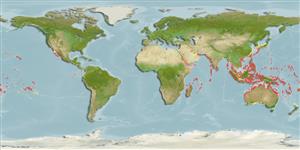Common names from other countries
Environment: milieu / climate zone / depth range / distribution range
Ecologia
Associadas(os) a recifes; intervalo de profundidade 0 - 35 m (Ref. 122), usually 1 - 3 m (Ref. 92930). Tropical; 32°N - 36°S, 30°E - 124°W
Indo-Pacific.
Length at first maturity / Tamanho / Peso / Idade
Maturity: Lm ?, range 22 - ? cm Max length : 35.0 cm TL macho/indeterminado; (Ref. 122); common length : 20.0 cm TL macho/indeterminado; (Ref. 122); Peso máx. publicado: 1.5 kg (Ref. 104244)
Maximum width: 10 cm (Ref. 418). Body wall thickness: 0.6 cm. Body elongate, arched dorsally (bivium and flattened ventrally (trivium). Bivium sometimes wrinkled; wider in the middle; and tapering towards both ends. Papillae on bivium long and slender. Podia numerous on trivium, stout and crowded on the radii and interadii; calcareous disc of podia around 500 micrometer in diameter. Mouth ventral, surrounded by 25 short and stout tentacles, with a large collar of long papillae at their base. Anus surrounded by 25 stout anal teeth. Calcareous ring showing large radial pieces and interradials with triangular top. Cuvierian tubules few (10), short pink, and never expelled. Color of bivium variable, usually dark brown, with more or less distinct whitish spots. Trivium grains, rods bearing small spines, and denticulate pseudo-plates; dorsal tegument without grains, but with rosettes and denticulate rods; podia with some spinous rods and large rosettes. Tentacles with large rods bearing small spines.
Maximum depth from Ref. 122570. Harvested by artisanal fisheries throughout the Western Central Pacific, but probably less frequently than other species of Actinopyga. Collected by hand while wading on the reef at low tide. Processed product is not distinguished from those of other Actinopyga species; moderate commercial value.
Sexual reproduction takes place during warm season. A species with a high potential fecundity and early sexual maturity (Ref. 122).
Conand, C. 1998. (Ref. 122)
Status na Lista Vermelha da IUCN (Ref. 130435: Version 2024-1)
Status no CITES (Ref. 108899)
Not Evaluated
Not Evaluated
Perigo para os humanos
Harmless
Uso pelos humanos
Pescarias: espécies comerciais
| FishSource |
Ferramentas
Fontes da internet
Estimates based on models
Preferred temperature
(Ref.
115969): 24.5 - 29.3, mean 28.4 (based on 3401 cells).
Resiliência
Baixo, tempo mínimo de duplicação da população 4,5 - 14 anos (K=0.12).
Vulnerabilidade
Moderate to high vulnerability (47 of 100).
Categoria de preço
Unknown.
